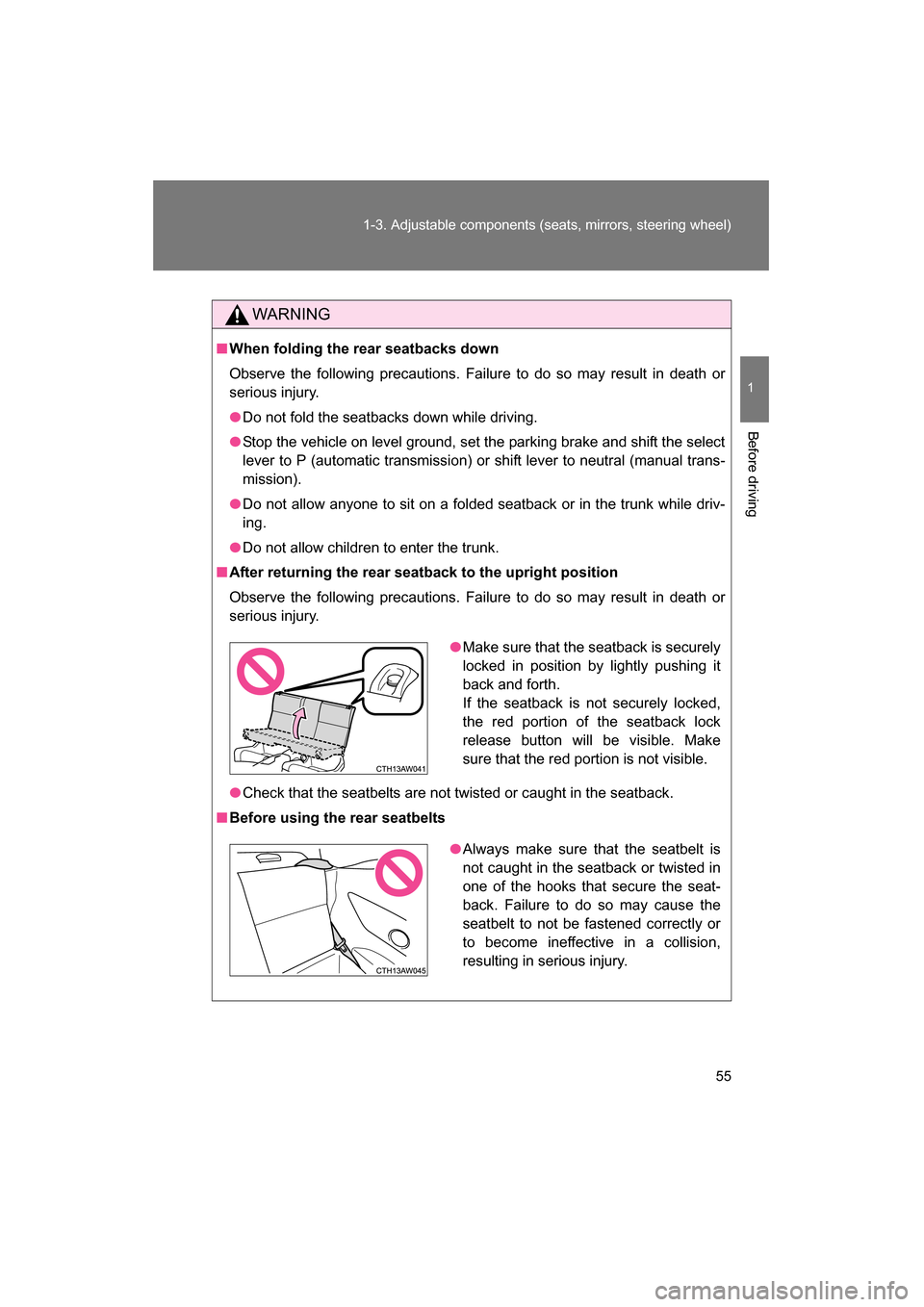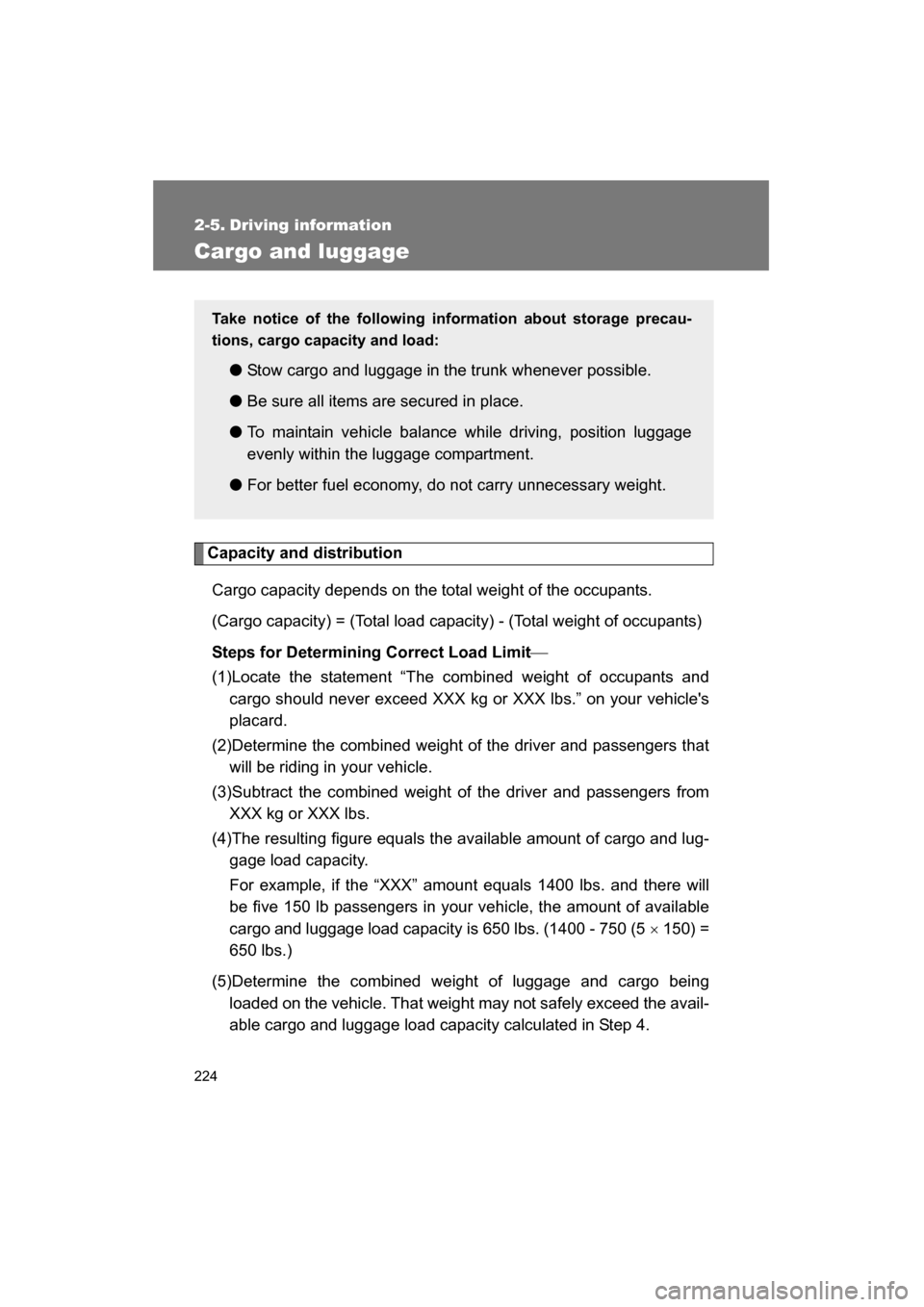Page 50 of 492
50
1-2. Opening, closing and locking the doors and trunk lid
CAUTION
■Trunk lid damper stays
The trunk lid is equipped with damper stays that hold the trunk lid in place.
Observe the following precautions.
Failure to do so may cause damage to trunk lid damper stays, resulting in a
malfunction.
●Do not attach any foreign objects such as stickers, plastic sheets and
adhesives to damper stay rods.
●Do not touch damper stay rods with gloves or other fabric items.
●Do not attach any accessories other than genuine parts to the trunk lid.
●Do not apply lateral force to damper stays or place your hand on it.
Page 54 of 492
54
1-3. Adjustable components (seats, mirrors, steering wheel)
Rear seats
■Seat dust cover
Always remove the seat dust cover that may be attached at the time of pur-
chase before using the seat.
The seatbacks of the rear seats can be folded down.
Pull the both left and right
seatback lock release straps
in the trunk lid to fold down the
seatback.To return the seatbacks to its
original position, lift it up until it
locks.
Page 55 of 492

55
1-3. Adjustable components (seats, mirrors, steering wheel)
1
Before driving
WARNING
■When folding the rear seatbacks down
Observe the following precautions. Failure to do so may result in death or
serious injury.
●Do not fold the seatbacks down while driving.
●Stop the vehicle on level ground, set the parking brake and shift the select
lever to P (automatic transmission) or shift lever to neutral (manual trans-
mission).
●Do not allow anyone to sit on a folded seatback or in the trunk while driv- ing.
●Do not allow children to enter the trunk.
■After returning the rear seatback to the upright position
Observe the following precautions. Failure to do so may result in death or
serious injury.
●Check that the seatbelts are not twisted or caught in the seatback.
■Before using the rear seatbelts
●Make sure that the seatback is securely
locked in position by lightly pushing it
back and forth.
If the seatback is not securely locked,
the red portion of the seatback lock
release button will be visible. Make
sure that the red portion is not visible.
●Always make sure that the seatbelt is
not caught in the seatback or twisted in
one of the hooks that secure the seat-
back. Failure to do so may cause the
seatbelt to not be fastened correctly or
to become ineffective in a collision,
resulting in serious injury.
Page 82 of 492
82
1-6. Security system
Alarm∗
The alarm’s default setting is set to off. To use the alarm, perform the
activating the alarm system procedures.
The system sounds the alarm and flashes the lights when forcible
entry is detected.
■Triggering of the alarm
The alarm is triggered when a locked door or the trunk lid is
unlocked or opened in any way other than using the “keyless
access” entry function or remote keyless entry system while the
alarm is set.
■Setting the alarm system
Close the doors and/or trunk lid and perform one of the follow-
ing: ●
Lock the doors using the “keyless access” entry function.
● Lock the doors using the remote keyless entry system.
● Lock the doors from the outside without using a key. (→ P. 44)
The system will be set auto-
matically after 30 seconds or
more elapse.The indicator light changes
from being on to flashing when
the system is set.
∗: If equipped
Page 83 of 492
83
1-6. Security system
1
Before driving
Activating/deactivating the alarm systemCheck that both side doors and the trunk lid are closed.
Turn the push-button ignition switch to “ON” mode. Open the driver ’s door while
pressing and holding on
the power door lock switch and
continue to press for
approximately 10 seconds after
the driver’s door has opened.
The alarm system changes
between activated and deacti-
vated as follows.
■Deactivating or stopping the alarm
Perform one of the following to deactivate or stop the alarm: ●Unlock the doors using the “keyless access” entry function.
● Unlock the doors using the remote keyless entry system.
● Turn the push-button ignition switch to “ACC” or “ON” mode,
or start the engine. (The alarm will be deactivated or stopped
after a few seconds.)
STEP 1
STEP 2
STEP 3
Alarm statusHornMulti-information dis-
play
Deactivated Sounds twice AL oF
Activated Sounds once AL on
Page 84 of 492

84
1-6. Security system
■System maintenance
The vehicle has a maintenance-free type alarm system.
■Items to check before locking the vehicle
To prevent unexpected triggering of the alarm and vehicle theft, make sure
of the following.
●Nobody is in the vehicle.
●The windows are closed before the alarm is set.
●No valuables or other personal items are left in the vehicle.
■Opening and closing the trunk lid
●If the alarm setting operations are pe rformed with the trunk lid left open,
the alarm will not be set. After closing the trunk lid, the alarm is set after
30 seconds or more elapse.
●When the trunk lid is unlocked using the “keyless access” entry function
or remote keyless entry system while the alarm is set, the alarm goes
into standby mode. After closing the trunk lid, the alarm is set again after
30 seconds or more elapse.
■Triggering of the alarm
The alarm may be triggered in the following situations.
Stopping the alarm deactivates the alarm system.
●A person inside the vehicle opens a
door or the trunk lid.
●The battery is recharged or replaced
when the vehicle is locked.
Page 136 of 492

136
1-7. Safety information
WARNING
■Child restraint precautions
●Do not allow the child to lean his/her head or any part of his/her body
against the door or the area of the seat, front and rear pillars or roof side
rails from which the SRS side airbags or SRS curtain airbags deploy even
if the child is seated in the child restraint system. It is dangerous if the SRS
side airbags and curtain airbags inflate, and the impact could cause death
or serious injury to the child.
●Make sure you have complied with all installation instructions provided by
the child restraint manufacturer and that the system is properly secured. If
it is not secured properly, it may cause death or serious injury to the child
in the event of a sudden stop, sudden swerve or an accident.
■When children are in the vehicle
Do not allow children to play with the seatbelt. If the seatbelt becomes
twisted around a child’s neck, it may lead to choking or other serious injuries
that could result in death.
If this occurs and the buckle cannot be unfastened, scissors should be used
to cut the belt.
■When the child restrain t system is not in use
●Keep the child restraint system properly secured on the seat even if it is
not in use. Do not store the restraint unsecured in the passenger compart-ment.
●If it is necessary to detach the child restraint system, remove it from the
vehicle or store it securely in the trunk. This will prevent it from injuring
passengers in the event of a sudden stop, sudden swerve or accident.
Page 224 of 492

224
2-5. Driving information
Cargo and luggage
Capacity and distributionCargo capacity depends on the total weight of the occupants.
(Cargo capacity) = (Total load capacity) - (Total weight of occupants)
Steps for Determining Correct Load Limit
(1)Locate the statement “The combined weight of occupants and cargo should never exceed XXX kg or XXX lbs.” on your vehicle's
placard.
(2)Determine the combined weight of the driver and passengers that will be riding in your vehicle.
(3)Subtract the combined weight of the driver and passengers from XXX kg or XXX lbs.
(4)The resulting figure equals the available amount of cargo and lug- gage load capacity.
For example, if the “XXX” amount equals 1400 lbs. and there will
be five 150 lb passengers in your vehicle, the amount of available
cargo and luggage load capacity is 650 lbs. (1400 - 750 (5 × 150) =
650 lbs.)
(5)Determine the combined weight of luggage and cargo being loaded on the vehicle. That weight may not safely exceed the avail-
able cargo and luggage load capacity calculated in Step 4.
Take notice of the following information about storage precau-
tions, cargo capacity and load:
● Stow cargo and luggage in the trunk whenever possible.
● Be sure all items are secured in place.
● To maintain vehicle balance while driving, position luggage
evenly within the luggage compartment.
● For better fuel economy, do not carry unnecessary weight.